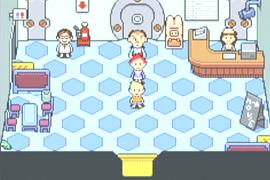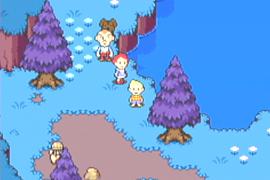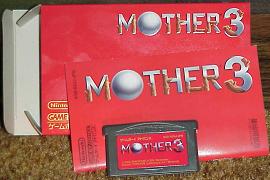
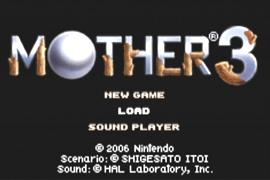


Before beginning the main part of the review, a bit of introductory preface is needed. Mother 3 is a GBA game which was released in Japan in April of 2006, and right now that's the only version available. While that's not that long ago, and it's always possible it might make its way over to the US, I was very anxious to play this game, and so decided to go ahead and get the Japanese version. I've generally not done much importing in the past, and the few that I do have don't require much understanding of the text in the game and so it hasn't been that much of an issue. Mother 3, on the other hand, is extremely heavily involved with the text. My knowledge of Japanese is limited to a single course of it that I took a couple of years ago. While it is something at least, it's not nearly enough to be able to, by myself, have any clue at all what's going on. After all, if I can understand one word out of twenty, that's nice and all, but, it's not really going to help me figure out what's going on as far as the story goes. Fortunately, there are a couple of very nice guides out there online, and so that's what I've been relying on as far as my understanding of the story goes. It's not perfect, and involves a bunch of going back and forth between the game and a computer screen or a printed piece of paper or something, and the delay between seeing what's happening on the screen and what's actually being said there, and means I have to follow along with what the guide's doing and where it's going. It's certainly better than sitting there looking at a bunch of stuff that I don't understand though. Still, it's just not the same as being able to play the game in a language that I do understand though, and, trust me, if the game ever does get an English release, I'll be out there on the first day to pick it up. Nonetheless, for the time being, this is what is out there at least, and so it's what's available to play.
Throughout the course of this review, a number of mentions and comparisons to the game Earthbound for SNES (which would be Mother 2 in this series) will be made. While it's generally not a good idea in a review to pre-suppose knowledge of another game for understanding of the game the review's for, I feel that it's alright in this case for a couple of reasons. The primary one being, of the three games in the Mother series, Earthbound is the only one to get an English release. As this review is written in English and on a primarily English website, likely most people reading it are going to be most comfortable understanding something written in English. So, simply for that reason, if one is interested in checking out the series at all and hasn't done so yet, Earthbound would definitely be the game to check out first. If one hasn't played that game and needs to know more about it, either to decide if it would be worth playing or just to get a better idea of some of the stuff this review is talking about, I do have a review of Earthbound that I've written as well which one can check out. On the other hand, if someone reading this is comfortable playing a game fully in Japanese and so wants to know which of them would be most worth playing first, it might not be the most helpful in that regard. Also, if one is used to importing and the languages issues and such, some of the matters discussed here will be a bit redundant, since, of course, one would know what to expect from an import game and be used to that already. Still, if one is most comfortable with English, it would definitely be recommended to check out Earthbound first. Not that one has to play it in order to understand this game, the storyline and play of it is fine to understand on its own. Just, as far as being able to get into the game in the most convenient manner, that would definitely be the one to try first. If one is most comfortable with playing a game in Japanese, though, there is also Mother 1&2 for GBA to check out. That said, if one has already played that game and enjoyed it, that's probably why one would be interested in this game as well.
The Mother series in general is a bit of an interesting progression. The first game, Mother was released for the Famicom in 1989. It was then in the process of being translated and prepared to bring it over to other territories in English for the NES, but, unfortunately, due to a variety of reasons, it never ended up making its way out. So, for the time being the series was confined to Japan. With Mother 2's release in Japan in 1994 however, that did have a happier ending as, in 1995 that made its way out in English for the SNES. Not only did it just make its way out, but it made quite the splash, with a bunch of advertising (hard to go wrong with a slogan like "This game stinks!" and scratch-and-sniff stickers), and the game itself came in an oversized box with a Player's Guide for the game included right inside. These various things definitely made the game stand out, and, it certainly caught the interest of many people. While playing the game, in one of the towns, there was a building marked as a "Planning meeting for Earthbound 2," and there were also a couple of different people who mentioned various things about a follow-up in the game. That, mixed with the game's ending and the stuff after the credits, definitely left plenty of hope that the game would see a follow-up. To put all those things in and not have a sequel would be kind of mean. Soon after that, came the release of the N64, and with that mention of an Earthbound 2/Mother 3 in planning for it. Talks ended up centering on development for an attachment in the works for the N64, named the 64DD. Development of the game, and the attachment itself, took a rather slow and often disheartening progress, to the point where things began to look doubtful either of them would ever see the light of day. Eventually, toward the end of 1999, the 64DD did make its way out, but in Japan only, and with only a handful of games released for it, none of which were the hoped-for follow-up to Earthbound/Mother 2. That slowly passed away, and with it hopes for the game to show up anywhere at all.
Moving forward a couple of years, in 2003 came word that planning of the game had made its way over to the GBA. Unfortunately, that word was followed up by a couple more years of silence. Then again in 2005 came mention that, yes, the game was indeed still being worked on, and that it did look like it would actually be released this time. Then, in April 2006, it finally happened, that the game actually made its way onto store shelves. Once it was on shelves, it really existed, right? So, that was definitely a good thing, the game really existed. The only problem was, as had been the case with Mother 1, it being in Japan only wouldn't do too much good if one was hoping for an English version. So, the waiting continued... and more waiting... and more waiting... and, well, here we are now in 2007, and still nothing. That's not to say it might not eventually make its way out here, but, it doesn't exactly look promising. So, if one was tired of all that waiting, the other alternative is, of course, just going out and getting the Japanese version. This is where this review brings us, to the Japanese version of Mother 3. So, with all of that preface out of the way, and an understanding of what lead to this point and why one would be interested in getting a game in Japanese in the first place, the more relevant points to the content of the review are, of course, questions about how the game plays, what it involves, is it fun, is it worth getting (although with, again, the language issue still kept in mind). So, that's what the rest of this is about, the actual game itself.
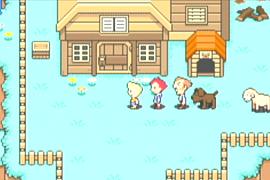
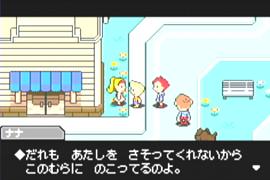
Mother 3 begins in a similar setting to what Earthbound did, minus the crashing meteor. One starts off as a small boy, happily asleep in his home, his father's out (although this time he'll actually be getting involved in things soon as opposed to just as a telephone), and a brother instead of a sister. Still, the general happy family situation where everything seems right and it's hard to imagine anything happening that would make things go wrong. As often happens, however, things do go wrong, and it will lead to a big adventure. Sure, it would be boring to just sit around at home all peaceful all the time, wouldn't make for a very interesting game. Still, it's such a happy time, that it's a shame to break it up. Unfortunately, some stuff is about to take place which one wouldn't expect, and definitely changes the mood of everything that's happening. A knock on the door, a reminder to change out of one's pajamas, and one is off on an adventure.
From what can be gathered about the storyline from the N64/64DD version that was in the works before disappearing, the story to Mother 3 for GBA appears to be relatively similar to the one from that game. In particular, a number of characters from the previous version show up in this game, and some of the scenes and dialog from the pictures and movies that had been shown of it are similar to that which are in this game. So, for anyone who did think what was going on in what was shown in that game seemed interesting, they'll definitely be happy to find some of it having made its way into this game. As well as that, another nice thing is that there are various references and things from Earthbound/Mother 2 showing up in this game. It's not like they took big chunks of that game and just recycled it for this game, there's certainly plenty of new stuff in this game as well. Still, there's a couple of areas, characters, music things and other various stuff which will have one smiling at the references, as well as some parts of the storyline. Not that one needs to have played the previous game to understand anything going on, everything in the game is explained just fine in the game. Still, it's nifty to see some of those things showing up again, giving the games a bit of a connected feel between them. For anyone who enjoyed Earthbound, they'll be happy to see the stuff that has shown up here as well.
The progress of the game is broken up into a series of "chapters" (and the beginning as a prologue). The way these chapters interact, however, especially towards the beginning, is quite interesting. Without trying to give away anything too much about the story away, the beginning couple of chapters are actually taking control of a couple of different groups of people playing through pretty much the same time period. One begins in control of the small boy you began as, and you add members to your party such as your dog (who is a more permanent fixture this time than he had been in Earthbound), playing through the prologue. Then, for the first chapter, which will reflect on the next couple as well, one takes control of the boy's father on his adventure. What he goes through will take him through a series of very interesting events, and eventually to a conclusion. Once one has finished up what he was doing, one begins a new chapter, this time in control of a thief, the son of the father's friend, whom you had encountered in the previous chapter. Another chapter will follow this, involving a couple of characters who he encounters working through his story, playing from their beginning, through the point where you encountered them in the previous chapter, and through some more events, including a couple of moments where you find yourself thinking "Aha! So that's why that happened to me before!" as you see yourself as the new characters causing these things to happen. It's a rather involved process, and with much more than what was covered above, but, of course, that's for one to find out while one is playing.
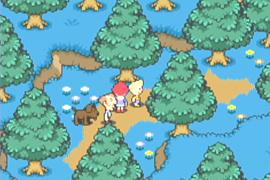
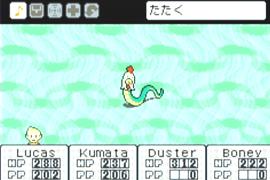
After the first couple of chapters, time moves forward a couple of years as certain events take place based on what had just finished happening in the previous overlapping chapters, and at that point the game has a feeling of beginning again, with a new and more direct feeling to the play (that is, working forward, as opposed to looping back on oneself). One will assemble a group of four out of an assortment of characters that one had played as in the previous chapters, who will be one's main party for the rest of the game, and begin work toward a new goal. With this new set group, one has a more firm feeling of the progress of play, and the building of the characters really begins. As in Earthbound, some of these characters can use special abilities (PK powers; or, as one might know them from Earthbound, PSI powers there) to cast spells with different effects, such as healing or causing damage to enemies. Also from this chapter forward, whereas in previous chapters there hadn't been any "normal" shops as one would think of them where one could buy stuff (and there is a particular reason in the storyline for this, it's not just a random thing), one will now be able to purchase items, weapons, accessories and such like that to improve one's characters. Similar to Earthbound, one earns the currency (here called Dragon Points) automatically through battle but needs to withdraw them (here using a frog, which functions like a combination of the phone and the ATM from Earthbound, with you using the frog to save your game or withdraw and deposit the Dragon Points). So, from this point, things take on a more familiar setup to what one would expect from the arrangement of Earthbound, fighting the enemies to improve your set group of characters, spending your Dragon Points on items and equipment, using PK powers, all of that fun stuff.
One complaint is that, while there are a bunch of areas to explore, pretty much all of them are within the same general area of each other. Really, although they're not broken up that way, the design of the world could almost be looked at as a main "hub" area of the initial starting town, and branches leading away from that place. That is, whereas in Earthbound one soon left the starting town behind and moved forward in a linear path away from there, in Mother 3 one will constantly be passing through the starting town, going one way or the other, but never really too far from it. In addition to that, there are also simply fewer towns that one goes through in the game than there were in Earthbound as well. While it's a fairly minor issue, one doesn't really get as much of a feeling of actually being on a long journey in this game, but more just kind of staying close to home taking care of the varying issues that are popping up around there. This isn't to say, again, that there aren't a number of very interesting places to go through, since there are certainly many of those. Just, the way it's set up seems a bit more limited than what was done in Earthbound.
As far as the actual play of the game, much of it is very familiar to what had been done in Earthbound, and, considering how well it worked there, that's definitely a good thing. As was the case there, while one is wandering around in the wild, one will see enemies on screen, who will either run up to you or run away from you depending on their level in relation to them, and one can try to avoid them if one isn't eager to get in a battle at that particular time. Depending on how you engage them, whether you approach them from the back, they catch you from the back, or directly, one will either have an extra attack at the beginning or miss one's first attack. One thing that's been added to this game, which effects not only battle but also one's progress in general, is the ability to dash while walking. This, needless to say, allows one to get from place to place much quicker than walking. Additionally, if one dashes into a weak enemy, it'll be tossed to the side without needing to engage it in battle. Unfortunately, unlike Earthbound's "automatic wins" with weak enemies, dashing into enemies here doesn't result in one gaining any experience or anything. So, if one is looking to maximize one's benefits from wandering around, one would still want to engage in the battle. Still, if one is in a hurry, or low on health, and just wants to get by, dashing works not only for getting through them, but also making it easier to avoid enemies in general. In battle, the HP and PP are again on a "rolling" counter, which means that, for instance, if an enemy did enough damage to kill you, but you kill the enemy before your HP finishes counting down to 0, the battle will end when the enemy dies, and you'll still have however much life you had when the battle ended. Similarly, if one has a chance to heal oneself before the counter gets down to 0, it will begin counting back up and one will still be alive. While it's not as noticeable a feature at the beginning when one doesn't have much HP and it counts to wherever it's going quickly, as one gets more and the numbers are larger, it definitely plays a part in the battle planning.
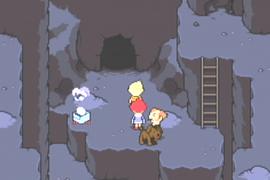
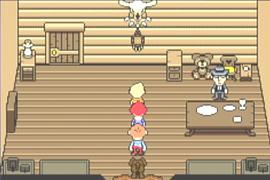
As was the case with Earthbound as well, Mother 3 has a very interesting look to its graphical appearance, which at first might not seem that exciting, but, as one plays the game, it quickly grows on one, to the point where it's hard to imagine the game looking any other way. Simply, the style of how the game looks just fits the mood of the game perfectly. This isn't to say the graphics are bad by any stretch, as they do indeed look very nice. Not only that, but, while it has the same charm to it as Earthbound's appearance, the detail and level of the graphics have definitely been pushed up here, where there's quite a noticeable improvement between the games. It has the same familiarity one would be hoping for, but with enough above it where one doesn't feel like one is just looking at the same things over again. Similarly with the music, it has much the same charm it did before (and in fact there are quite a number of tunes which will remind one of something from Earthbound), but with plenty new of its own. Not only that, but the music actually plays an integral part in the battles. While it's often quick tricky to pull off, if one times an attack so that the impact is in tune with the music playing, it will result in a combination attack with more hits coming off in succession with further beats of the music. It's not imperative that one figure all this out, and indeed one can simply play by pushing away at the button and taking one's chances (and one will get stuff to happen on occasion just out of luck), but, it's a very interesting feature if one takes the time to really work at it.
As noted, my knowledge of Japanese is extremely limited, and so I've had to rely on written guides for my understanding of most of what is going on. That said, I am able to at least read the Hiragana/Katakana and see what letters they represent, and sometimes that's enough. For instance, the different PK spells have names such as "PK Furiizu Alpha" and "Hiiringu Alpha," which, with a bit of thinking, one can realize that "Furiizu" is Freeze and "Hiiringu" is "Healing," and other such things like that. Also, different items, even if you can't understand their description, if they say something like "HP 60" you can figure out that, whatever it is, it's going to raise your HP by 60. Or, on one's statistics screen, even if one can't read what is written, it's easy enough to find one's HP and PP information, one's experience and experience to the next level, statistics information, and other important things like that which are represented by numbers. Numbers are numbers after all. The unfortunate thing is, while the items and PK abilities and such have descriptions when viewing them outside of battle, when viewing them in battle, all that's visible is the name. So, if one is planning to use something (especially items) in battle, one kind of has to remember what does what. With the PK abilities though, it's easier since it goes by default to what it's affecting. For instance, a spell which can hit multiple enemies will automatically appear with multiple enemies selected. So, it's not too hard to figure out for those what thing is doing what. Still, even if one can't understand what is written, at least a bit of memorization of what string of symbols is doing what will be helpful. Nonetheless, it's all fairly straightforward, and shouldn't be too much of a problem.
Most of the gripes I might have about this game, unfortunately, are either directly or indirectly tied to the fact that I'm playing it in a language that I don't understand, and having to rely on a separate written guide to find out what's happening. For instance, the towns in this game don't seem nearly as engaging as the towns in Earthbound, where here it feels like one is just stopping in there to do what one needs to do, whereas in Earthbound one could spend a bunch of time just aimlessly wandering around the town exploring and talking to people and such. The thing is though, if one is just reading what the characters are saying off a piece of paper, one doesn't need to have gone around the town looking for them to see what they say (and, if one found them, one wouldn't be able to understand it anyway). Likewise, it's hard to do too much exploring off on one's own, since, if one wanders too far from where the text or guide one is using is explaining, one isn't going to be too sure what's going on, and it might be hard to find where to rejoin what they're saying from where one had wandered. Not to say one can't do any wandering at all (certainly, going through a forest just randomly fighting enemies is the same in any language, and if one is just going back to where one started in the end it isn't any problem), but, it's a bit of a barrier in the way of the random stuff one might want to be doing.
That said, those are minor issues compared with how enjoyable the game is as a whole. The language problem is, of course, the most daunting thing to overcome. Once one is able to get over that initial feeling of confusion, either thanks to the help of online guides or just getting used to not being able to understand some stuff, and is able to get into the heart of the game, it's really a spectacular thing. The actual storyline of the game, once one is able to understand it, is really very good, as are the little side things one has to do along the way. The different areas one passes through are all very fun to wander around in, just looking at the surroundings and fighting the interesting assortment of enemies. The battles, rather than feeling tiresome and in the way of what one is trying to do, are plenty of fun on their own, where one could easily spend some time just fighting enemies not because one needs to do so, but just because it's another thing in the game that one can do which is enjoyable. As a ballpark figure, easily expect to spend around 35-40 hours going through the game, or more depending on just how much time one spends wandering around. Every minute of it is interesting too, there really isn't a single dull moment in there. Even once one has beaten the game, it's just so enjoyable going through all the areas, exploring and looking at everything, that one will definitely have the urge to do it again. Not to mention, of course, that after having gone through it once one will then have a better idea of what one needs to be doing, and so not have to worry as much about being confused by not understanding things.
It's a shame that this game hasn't come out in other regions yet, and if it never ends up doing so, it's definitely a huge loss. This is easily one of the best, if not the best, games ever released for the GBA, or any system really. That doesn’t mean one should miss out on this, however, as, even with not being able to understand directly oneself what's going on in there, it's still a spectacular game. It's more difficult of course, and if it ever does come out in English, even if one has already played through this version, it would definitely be something to get. Still, for anyone who enjoyed Earthbound, who had been waiting all this time for a sequel, through all the ups and downs of that journey, this is a great reward to have at the end of this. It's not quite as good as Earthbound was, but, that's a pretty tall order for any game. Still, in its own right it's a spectacular game, and as a follow-up to Earthbound it's definitely everything one could hope for. If any game could be worth a ten-year wait and playing in a language one can't understand, this definitely fits that description. The waiting is over, the game is out there, and it was worth it.
